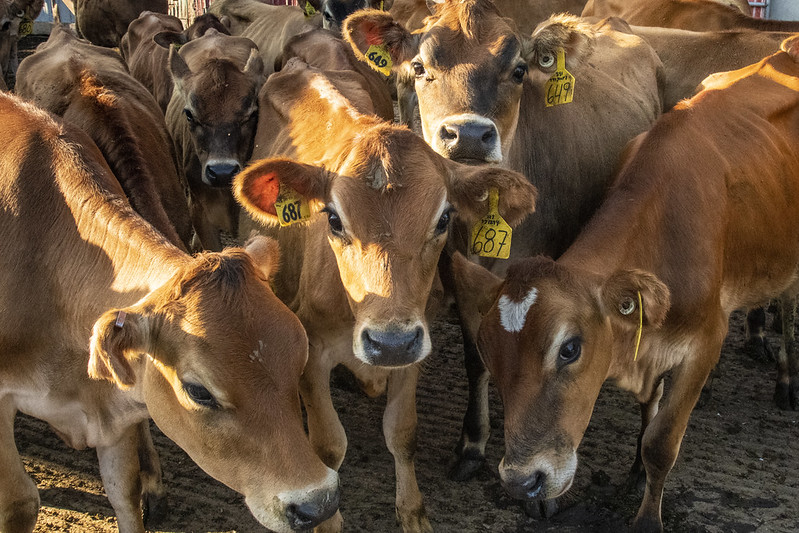Walmart triggered an evolution among its supply chain partners with its 2016 announcement to sustainably source 20 key commodities by 2025. The retail giant furthered its commitment in 2020 when it pledged to become a regenerative company, including a commitment to help protect, manage or restore at least 50 million acres of land and 1 million square miles of ocean by 2030 with the Walmart Foundation.
The company’s suppliers quickly shifted into action, and together with Walmart, they have since unleashed a flurry of achievements that is moving the needle on regeneration, notably in its animal proteins business.
One of the company’s 2025 goals is to source beef more sustainably, and it is working with producers to implement and measure conservation practices among its rancher-suppliers.
Trust In Food hosted Walmart sustainability leaders Mikel Hancock, Senior Director of Sustainable Food and Agriculture, and Tyler Lehr, Senior Vice President of Deli Services, Meat and Seafood, to discuss the company’s commitment and journey toward regeneration, along with its sustainability initiatives with its rancher-suppliers during the Trust In Food Virtual Symposium Feb. 23. You can still view the full video interview and the entire Virtual Symposium on-demand when you register here.
Using Scale For Good
Walmart’s sustainability journey began in aftermath of Hurricane Katrina in 2005, when the company used its resources and reach to deliver humanitarian aid to the Gulf Coast. “We realized we could use our scale for good,” Hancock says.
The result was three company moonshot aspirations:
- To be powered by 100% renewable energy
- To generate zero waste in its operations
- To sell sustainable products that are good for people and the planet
Today the company has 80% of its waste diverted from landfills or incineration in its global supply chains. It is powered by 30% renewable energy and it is looking to grow that number in the future. And its supply chain and products are becoming more sustainable, including its store-brand jeans that are made from recyclable materials.
“But we recognize that it’s not enough,” Hancock says. “And as you take a look at what is taking place right now, we have issues around deforestation; we have issues around products in our supply chain, such as seafood that is being overfished, and you also have issues around soil loss that is taking place and water quality issues, and so for us, it’s one of those times when we recognize that we’re going to have to do more.”
Now the company is using its commitment to regeneration to protect, manage and restore natural ecosystems by addressing, decarbonizing its supply chain and collaborating on place-based agricultural efforts.
Meeting Producers Where They Are
With Walmart’s 2025 goals on the horizon, it now sustainably sources 100% of its private brand coffee, and a line of its Great Value shelf-stable tuna is Marine Stewardship Council (MSC) Certified. Its next target will be for all of its fresh, frozen, farmed and wild-caught seafood suppliers to source from fisheries that are third-party certified as sustainable or actively working toward certification or improvement.
“We do have a planet in crisis,” Lehr says. “And we believe that we have a responsibility at Walmart to lead the way and change the way food and other things are sustainably sourced.”

The company’s sustainable beef initiative also falls into its 2025 goals. Lehr says there are three key components to its beef goals:
- Soil health: It is working with producers and suppliers to improve grain sourcing and grazing management practices across 12 million acres.
- Animal welfare: Walmart supports the globally recognized five freedoms of animal welfare and expects its supply chain partners to do the same.
- Antibiotics: It continues to ask ranchers for transparency by providing antibiotic management reporting on an annual basis.
Lehr says Walmart recognizes that ranchers are already doing a phenomenal job in land management practices and animal welfare, and it can add additional value with support and resources for assessment and ideas for new practices that can help ranchers on their journey of continuous improvement. Above all, it’s a collaboration and an understanding that everyone is in a different place on their regenerative journey, and there are mutually beneficial incentives for suppliers and retailers.
“One of the things that we want to do is have open conversation with ranchers. We learn a lot when we sit down and discuss the business together,” Lehr says. “First, we learn about the great care of what they’re doing already in land management practices, and we take those into account and learn from that. Second, we’ve come to learn that there is no one-size-fits-all approach. What’s right for one area might not be exactly right for the next, so we want to work with our ranchers to tailor the best approach and what works for them on a case-by-case basis.”
Partnerships Are Paramount
Walmart is dedicated to taking a journey with its partners and leveraging a shared-value approach to regeneration. It joined the Pacific Island Tuna joint venture with the Republic of the Marshall Islands and The Nature Conservancy that directs substantial portion of its long-term profits back to the Pacific islanders while utilizing a sustainable model of fishing and production.
As part of the deal, a significant portion of the net income will directly support community-based conservation and climate resilience projects in low-lying areas. As a low-lying island nation, climate resiliency efforts are critical for the Marshall Islands as they try to counter the threat of rising sea levels – which can also have devasting effects on fisheries, a potential disaster considering almost 90% of the nation’s non-aid income comes from the tuna industry. The remaining profits will be returned to Pacific Island governments.
For ranchers in the U.S., Walmart Foundation, Cargill and McDonald’s are investing over $6 million in an initiative led by World Wildlife Fund that aims to make lasting improvements to the grasslands of the Northern Great Plains. The Ranch Systems and Viability Planning network, launched in 2020, supports ranchers primarily in Montana, Nebraska and South Dakota with technical expertise, training and tools to help advance grazing practices that improve the health of the land. By improving management of 1 million acres over five years and avoiding conversion, the program will result in increased carbon storage and sequestration, improved water infiltration and better outcomes for biodiversity.
“All those things are critically important to the long-term success for those producers to be able to have cattle on their land and also the environmental impact as well,” Hancock says.
“We have our aspirations. We ask suppliers to come along on this journey with us. Walmart can’t do it alone. We talk about collective action. It’s about leveraging those who are closest to the supply chain. Walmart is at the very end. We have tools and resources that we can make available to them to be able to report on great progress,” Hancock says. “We can also help them assess where they are at today and what will drive true change, but it’s going to take all of us to work together within it, so we invite them along for the journey. We love to give them great credit for it because it’s really about all the great work they’re doing in the supply chain.”



